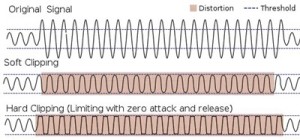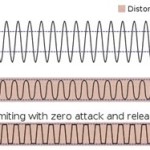Language
The Difference Between Clipping and Limiting
 There’s a lot of specific terms out there in the world of recording that you’re going to have to grasp in order to get the most out of your mixes, many of which are just slightly different from another, such as clipping and limiting. Essentially, clipping happens when gain structure receives more than it can handle while limiting is the controlled process of gain reduction to avoid clipping in the first place. Although different, both are non-linear processes and both introduce distortion products. There’s also soft clipping which is essentially a combination of limiting before clipping. It’s still clipping but with a slightly less aggressive beginning.
More specifically, clipping happens when a signal’s amplitude goes above the maximum capability of the system. When this happens, the output of the signal suddenly stops at the voltage limit making the tops and bottoms of the audio wave cut off. Strong harmonic distortion is then inevitably created. To get more specific, the system is entirely linear up to the clipping level but after that, extremely non-linear, meaning that signals below the clipping level are unaffected while those higher or at the clipping level are jumbled. This adds complex additional harmonics that weren’t there in the original signal.
As far as analog goes, if the clipping is very slight, the resulting distortion is hardly audible. On the other hand, if the system is digital, it’s most definitely audible! The reason we’re able to hear digital clipping so easily is because it produces very unnatural sounding anharmonic distortion through aliasing. Digital clipping become even more noticeable when the signal source has a well-defined harmonic structure, such as voices, pianos and the like. Conversely, noise-like sources like cymbals and snare drums produce more noise-like distortion when aliased. This means that although the timbre might change slightly, it usually won’t come off sounding like distortion.
Limiting on the other hand is completely a more controlled operation, where a high amplitude signal is slightly attenuated explicitly to avoid clipping. Temporary dynamic changes do occur and introduce a type of distortion but it is very trivial and hardly recognized as such. The system remains linear until the limiting level, after which the waveform is reduced in amplitude, although it does retain its original shape more or less, remaining harmonically complete. The resulting distortion is usually insignificant.
We suggest that when possible, clipping should always be avoided and a fast-acting limiter should be the first choice for peak control. But it must be said that since we are talking about music, there’s always room for rule-breaking when a song calls for it, such as the harmonic distortion produced through analog clipping when used in the right circumstance. This creates a very different type of sound.
But with all the said, the sound you’re going for is going to ultimately determine whether limiting, clipping or soft clipping is the best choice. Most tend to stay away from digital clipping because of the very noticeable sound it produces but then again, there are those that like it.
There’s a lot of specific terms out there in the world of recording that you’re going to have to grasp in order to get the most out of your mixes, many of which are just slightly different from another, such as clipping and limiting. Essentially, clipping happens when gain structure receives more than it can handle while limiting is the controlled process of gain reduction to avoid clipping in the first place. Although different, both are non-linear processes and both introduce distortion products. There’s also soft clipping which is essentially a combination of limiting before clipping. It’s still clipping but with a slightly less aggressive beginning.
More specifically, clipping happens when a signal’s amplitude goes above the maximum capability of the system. When this happens, the output of the signal suddenly stops at the voltage limit making the tops and bottoms of the audio wave cut off. Strong harmonic distortion is then inevitably created. To get more specific, the system is entirely linear up to the clipping level but after that, extremely non-linear, meaning that signals below the clipping level are unaffected while those higher or at the clipping level are jumbled. This adds complex additional harmonics that weren’t there in the original signal.
As far as analog goes, if the clipping is very slight, the resulting distortion is hardly audible. On the other hand, if the system is digital, it’s most definitely audible! The reason we’re able to hear digital clipping so easily is because it produces very unnatural sounding anharmonic distortion through aliasing. Digital clipping become even more noticeable when the signal source has a well-defined harmonic structure, such as voices, pianos and the like. Conversely, noise-like sources like cymbals and snare drums produce more noise-like distortion when aliased. This means that although the timbre might change slightly, it usually won’t come off sounding like distortion.
Limiting on the other hand is completely a more controlled operation, where a high amplitude signal is slightly attenuated explicitly to avoid clipping. Temporary dynamic changes do occur and introduce a type of distortion but it is very trivial and hardly recognized as such. The system remains linear until the limiting level, after which the waveform is reduced in amplitude, although it does retain its original shape more or less, remaining harmonically complete. The resulting distortion is usually insignificant.
We suggest that when possible, clipping should always be avoided and a fast-acting limiter should be the first choice for peak control. But it must be said that since we are talking about music, there’s always room for rule-breaking when a song calls for it, such as the harmonic distortion produced through analog clipping when used in the right circumstance. This creates a very different type of sound.
But with all the said, the sound you’re going for is going to ultimately determine whether limiting, clipping or soft clipping is the best choice. Most tend to stay away from digital clipping because of the very noticeable sound it produces but then again, there are those that like it.
